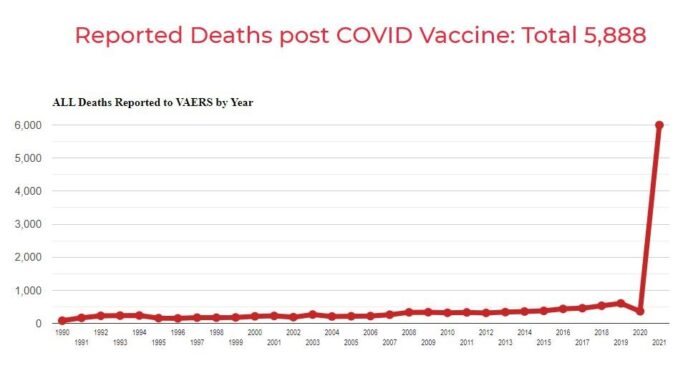BS. We've never seen vaccine-induced death on this scale. June data:
More deaths than all prior vaccine deaths combined since records have been kept. VAERS is now at 17,000+ and hasn't been updated in quite some time.
So you're asking us to believe they were hiding all prior vax deaths better than they are Covid Vax deaths?
That chart is grossly misleading for at least five reasons:
1) To start off, it can't be a chart of "Reported deaths post COVID vaccine", because there was no COVID vaccine prior to 2020. So the heading is wrong, and is likely a chart of
all VAERS reports for
all vaccines. The chart is also uncited.
If I made a chart that said "Deaths that occurred on Sunday", and plotted it against the entire week, it would look the same for the same reasons.
2) It's misleading because of the nature of what VAERS reports.
From the CDC requirements:
"Everyone is encouraged to report possible adverse events after vaccination to VAERS,
even if they are not sure whether the vaccine caused the problem. In general,
you should report any side effect or health problem after vaccination that is concerning to you."
So by definition, VAERS would always be a superset of vaccine-implicated deaths, not deaths confirmed to be caused by vaccine. And this also applies to
any vaccine as well.
3) The chart isn't normalized to doses, which is a better way of calculating risk. Even for sake of argument, let's take for granted that all 17k+ deaths were directly attributed casually to a vaccine. There have been close to 450 million doses given in America alone: that is an incident rate of 0.0034%.
And even this is not really correct, because the proper denominator for event risk is events divided by dose-years, to account for the fact that all of the doses weren't an impulse response at a specific time, and to factor in the difference between someone who drops dead when the needle goes in, versus someone who dies of old-age 60 years later (both are strictly post vaccination deaths). But the point is the same.
4) The chart is not normalize for excess deaths (deaths that would have occurred even if no vaccines had existed). And due to the definition of VAERS data it never can be: this has to be carefully studied and accounted for.
5) The reality of the situation is that mandated vaccines (and all vaccines in general), are normally spread out over a 4-6 year term, and normally given (mostly) to children and young adults. This spreads the risk profile out for the entire population over a wide amount of time, and centers the risk profile into only a 20-25% of the general population.
That didn't happen with COVID: all of the doses were administered in mass to a large chuck of the population (18+ years old until recently) over a very short timeframe (roughly 1 year at this point).
If you want to see a chart of studied post-vaccination events, that properly accounts for person-years and excess risk ratios, here is an example (
Surveillance for Adverse Events After COVID-19 mRNA Vaccination):
You can see that the most statistically relevant excess case in the 6 million person study was venous thromboembolism (aka. a deep vein blot clot), with an excess risk of 7.5 cases per million doses. Clots are one of the major confirmed side effects, however the risk of getting one is 3 orders of magnitude less than dying of COVID in the first place.
To quote crazydoc, those are chances I would take any day.


















![Electronics Soldering Iron Kit, [Upgraded] Soldering Iron 110V 90W LCD Digital Portable Soldering Kit 180-480℃(356-896℉), Welding Tool with ON/OFF Switch, Auto-sleep, Thermostatic Design](https://m.media-amazon.com/images/I/41gRDnlyfJS._SL500_.jpg)
















